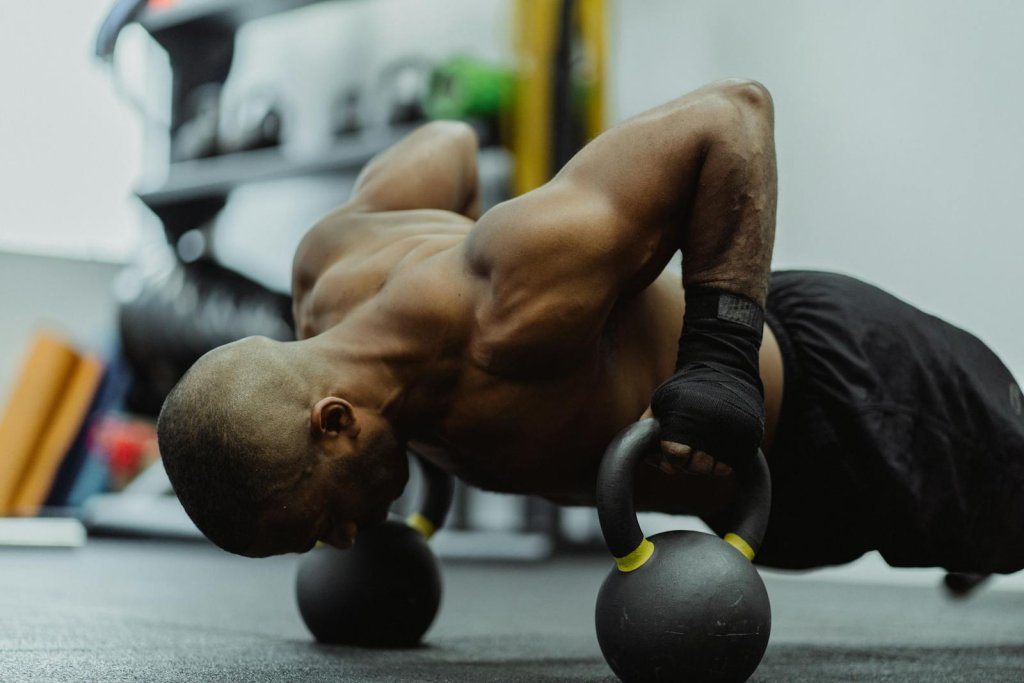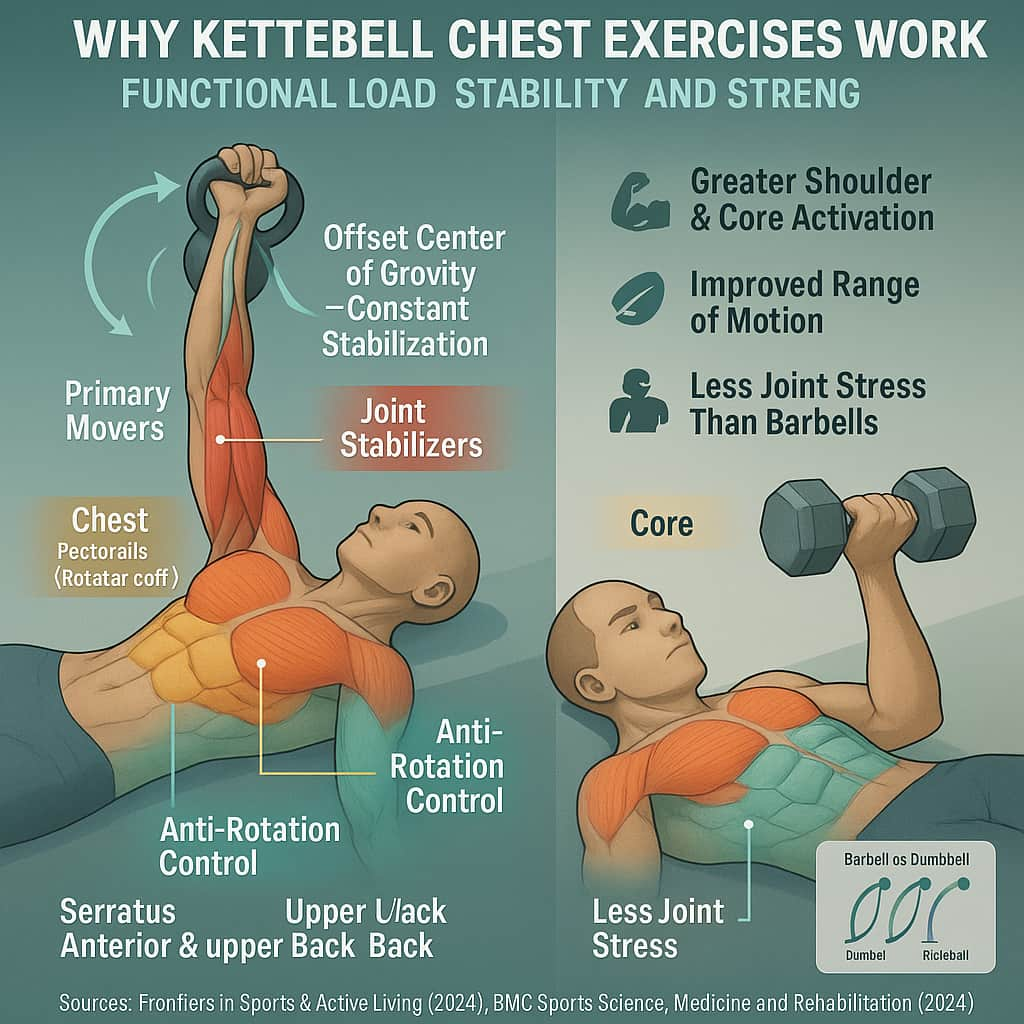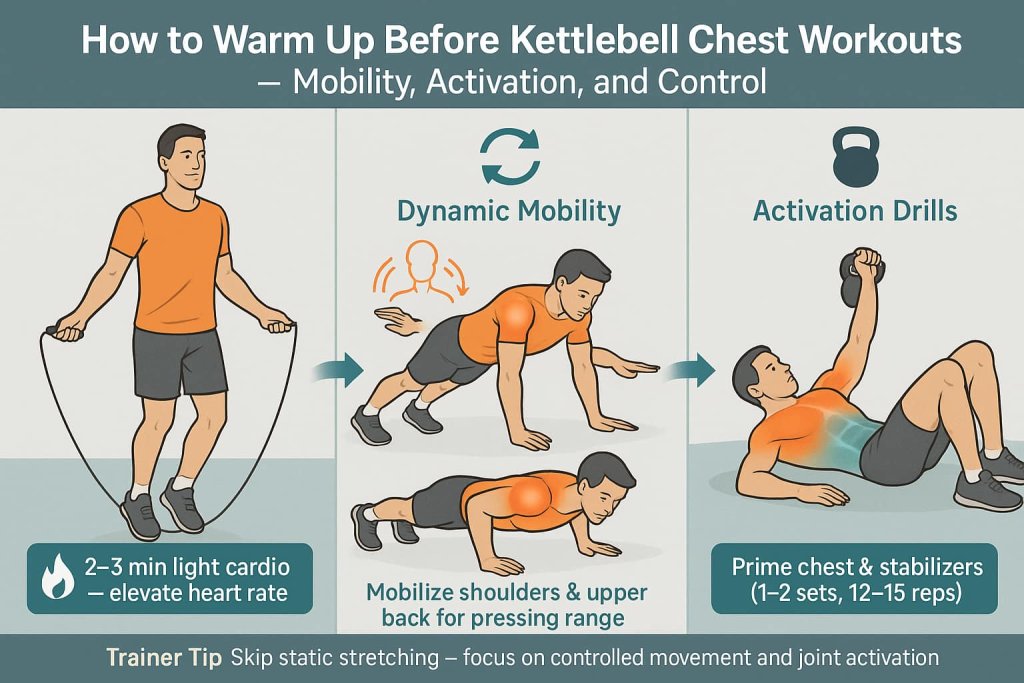Yes — you can build a stronger, more defined chest using just kettlebells. Kettlebell chest exercises engage your pectoral muscles, shoulders, and triceps while challenging your balance and stability far more than traditional weights.

Understanding how to train your chest with kettlebells is key to developing upper-body power, posture, and control — especially if you train at home or without access to machines. You’ll discover the best moves, how to do them safely, and what makes kettlebell training uniquely effective for your pecs.
Why Kettlebell Chest Exercises Work
Unlike barbells or dumbbells, a kettlebell’s center of gravity hangs below its handle, forcing your chest, shoulders, and stabilizers to engage throughout each movement. This increases time-under-tension, improves joint control, and builds balanced upper-body strength.

Benefits include:
- Greater shoulder stability and control.
- Improved chest activation through deeper range of motion.
- Enhanced coordination and core involvement.
- Reduced wrist and shoulder stress compared to barbells.
Research Insight:
Emerging evidence shows kettlebell training improves strength and stability. For example, a 2024 study in Frontiers in Sports & Active Living reported substantial trunk and shoulder activation during kettlebell swings, while a 2024 randomized trial in BMC Sports Science, Medicine and Rehabilitation found kettlebell training improved fitness outcomes similarly to structured bodyweight training.
Muscles Worked by Kettlebell Chest Exercises

- Pectoralis Major and Minor – Primary movers that drive pressing and flye movements.
- Anterior Deltoids – Assist chest activation and shoulder flexion.
- Triceps Brachii – Support elbow extension during all push movements.
- Core Stabilizers – Maintain alignment and resist rotation during single-arm presses.
- Serratus Anterior & Upper Back – Stabilize shoulder blades for efficient force transfer.
How to Warm Up Before Kettlebell Chest Workouts

Always warm up your chest and shoulders before lifting to improve mobility and reduce injury risk.
Quick Warm-Up Routine:
- Light Cardio (2–3 min): Jump rope or brisk arm swings.
- Dynamic Mobility: Arm circles, scapular push-ups, and torso twists.
- Activation Drills: Band pull-aparts and light kettlebell presses (1–2 sets of 12–15 reps).
Trainer Tip:
Skip static stretching before lifting — focus on movement and joint activation.
15 Best Kettlebell Chest Exercises
These kettlebell chest exercises combine pressing, push-up, and flye variations to build strength, definition, and joint stability. Perform them with control to maximize muscle activation and protect your shoulders.
1. Kettlebell Floor Press
Why it works:
This movement builds pressing strength while protecting your shoulders. The floor limits excessive range of motion, reducing joint stress while emphasizing the mid and lower chest fibers. The kettlebell’s offset weight also challenges shoulder stability and wrist control.
Muscles worked:
Pectoralis major, anterior deltoids, triceps, and core stabilizers.
How to do it:
- Lie flat on your back with knees bent and feet on the floor.
- Hold two kettlebells beside your chest with neutral grip (palms facing inward).
- Press both weights straight up until arms are fully extended.
- Lower under control until elbows lightly touch the floor.
Trainer Tip:
Keep your elbows at about 45 degrees from your torso. Avoid bouncing the weights — pause briefly before pressing back up.
2. Kettlebell Bench Press
Why it works:
This variation replicates a barbell bench press but adds a dynamic stabilization element. Each arm works independently, engaging your core and preventing muscle imbalances.
Muscles worked:
Pectoralis major, anterior deltoids, triceps, and serratus anterior.
How to do it:
- Lie on a flat bench holding a kettlebell in each hand at chest level.
- Use a neutral grip and press both weights upward until arms are extended.
- Slowly lower them back to the starting point.
Trainer Tip:
Keep wrists stacked over elbows and move smoothly. Avoid overextending elbows at the top.
3. Single-Arm Kettlebell Floor Press
Why it works:
By pressing one arm at a time, this version enhances core engagement and anti-rotation stability, teaching you to control asymmetrical loads.
Muscles worked:
Chest, triceps, anterior deltoid, and obliques.
How to do it:
- Lie on your back with knees bent.
- Hold one kettlebell at chest level while keeping your opposite arm extended on the floor for balance.
- Press the kettlebell upward until your arm is straight, then lower slowly.
Trainer Tip:
Engage your abs to prevent torso rotation during the press.
4. Kettlebell Squeeze Press
Why it works:
Constantly squeezing the kettlebells together activates the inner chest, improving definition and midline strength.
Muscles worked:
Inner and middle chest, triceps, and shoulders.
How to do it:
- Lie on your back or a bench, holding two kettlebells together at chest level.
- Squeeze them toward each other and press upward.
- Maintain pressure as you lower them back down.
Trainer Tip:
The key is maintaining inward pressure throughout the entire motion for maximum inner-pec activation.
5. Kettlebell Flye (Floor or Bench)
Why it works:
The flye isolates the chest through a wide, controlled arc, promoting stretch and hypertrophy across the pec fibers.
Muscles worked:
Pectoralis major, anterior deltoid, and stabilizing forearms.
How to do it:
- Lie on your back or a flat bench holding a kettlebell in each hand above your chest.
- Lower the bells slowly outward until you feel a stretch in your chest.
- Bring them back together over your chest using controlled motion.
Trainer Tip:
Keep a slight bend in your elbows and move through a slow, steady range to avoid shoulder strain.
6. Kettlebell Push-Up
Why it works:
Elevating your hands increases the range of motion and intensifies chest activation. The unstable handles force your stabilizers to work harder.
Muscles worked:
Chest, triceps, shoulders, and core stabilizers.
How to do it:
- Place two kettlebells shoulder-width apart on the floor.
- Grip the handles firmly and extend into a plank position.
- Lower your chest between the bells and press back up.
Trainer Tip:
Keep wrists neutral and core tight to prevent wobbling.
7. Deficit Kettlebell Push-Up
Why it works:
By lowering your chest below hand level, you achieve a deeper stretch, leading to greater pec engagement and range of motion.
Muscles worked:
Pectoralis major and minor, deltoids, triceps, and serratus anterior.
How to do it:
- Hold onto two kettlebell handles in a push-up position.
- Lower your chest until it dips slightly below the handles.
- Push through your palms to return to start.
Trainer Tip:
Maintain a neutral spine and avoid letting your hips sag.
8. Alternating Kettlebell Press
Why it works:
This variation trains one side at a time, increasing unilateral strength, shoulder coordination, and balance.
Muscles worked:
Chest, shoulders, triceps, and obliques.
How to do it:
- Lie flat on a bench or floor holding two kettlebells.
- Press one kettlebell up while holding the other at chest level.
- Lower and alternate sides.
Trainer Tip:
Slow the tempo and control each press to improve symmetry.
9. Kettlebell Renegade Row-to-Press
Why it works:
Combining a row and press builds chest and back strength while enhancing core stabilization — an ideal full-body power move.
Muscles worked:
Chest, lats, triceps, shoulders, and core.
How to do it:
- Start in a push-up position gripping two kettlebells.
- Row one kettlebell toward your ribs, then perform a push-up and press the opposite arm forward.
- Alternate sides.
Trainer Tip:
Widen your stance for balance; move deliberately, not explosively.
10. Kettlebell Chest Pullover
Why it works:
Combines chest and back engagement, strengthening the pectorals and lats for balanced upper-body development.
Muscles worked:
Upper chest, lats, triceps, and serratus anterior.
How to do it:
- Lie on your back holding one kettlebell over your chest with both hands.
- Slowly lower it behind your head until your arms align with your ears.
- Pull the kettlebell back to the start position using your chest.
Trainer Tip:
Maintain a slight elbow bend and control the motion throughout.
11. Incline Kettlebell Press
Why it works:
Targets the upper pecs and front delts, creating a fuller, lifted chest appearance.
Muscles worked:
Upper pectoralis major, anterior deltoids, and triceps.
How to do it:
- Set a bench to a 30–45° incline.
- Hold two kettlebells at chest height and press them upward.
- Lower with control until elbows are just below shoulder level.
Trainer Tip:
Avoid flaring your elbows outward — keep them slightly tucked for shoulder safety.
12. Kettlebell Fly-to-Press Combo
Why it works:
Combines the stretch of a flye with the contraction of a press to maximize muscle recruitment in one movement.
Muscles worked:
Chest, deltoids, triceps, and stabilizing forearms.
How to do it:
- Begin in a flye position; lower the bells outward, then bring them together.
- Immediately perform one press before repeating the sequence.
Trainer Tip:
Use lighter kettlebells — this combo doubles your time under tension.
13. Kettlebell Floor Pullover-to-Press
Why it works:
Integrates multiple muscle groups — chest, triceps, and core — while improving shoulder mobility.
Muscles worked:
Chest, triceps, lats, and core.
How to do it:
- Lie flat and hold one kettlebell over your chest.
- Lower it behind your head, then bring it back forward and press.
Trainer Tip:
Engage your abs and keep your ribcage from flaring upward.
14. Kettlebell Dead Stop Push-Up
Why it works:
Pausing at the bottom eliminates momentum, forcing pure strength output from the chest and triceps.
Muscles worked:
Chest, triceps, shoulders, and core.
How to do it:
- From a plank position, lower until your chest touches the floor.
- Pause briefly, then explosively push back to the top.
Trainer Tip:
Squeeze your glutes and brace your abs for full-body tension.
15. Kettlebell Stability Press (on Ball or Floor)
Why it works:
Unstable surfaces activate deep stabilizers and improve shoulder coordination and balance.
Muscles worked:
Chest, triceps, shoulders, core stabilizers, and rotator cuff.
How to do it:
- Sit or lie on a stability ball holding two kettlebells at chest level.
- Press upward slowly, maintaining control and balance.
- Lower with steady motion.
Trainer Tip:
Focus on slow tempo and even control — don’t let the kettlebells drift apart.
Programming Tips
- Frequency: 2–3 sessions per week.
- Reps: 8–12 for hypertrophy, 12–15 for endurance.
- Sets: 3–4 per exercise.
- Rest: 60–90 seconds between sets.
- Progression: Increase load or slow tempo to enhance tension.
Safety & Precautions
- Warm up shoulders and wrists before lifting.
- Choose moderate weights that allow full control.
- Avoid jerky movements — prioritize slow, controlled reps.
- If you have shoulder pain, substitute pressing for flye variations.
Common Mistakes to Avoid
Avoid these errors to protect your shoulders and get the best results:
- Flaring elbows too wide during presses.
- Lifting heavier than you can stabilize.
- Skipping warm-up or core engagement.
- Using momentum instead of controlled movement.
- Letting shoulders shrug forward.
Trainer Tip:
Slow down every rep, keep tension in your core, and prioritize perfect form over load.
FAQs
1. Can kettlebells replace dumbbells for chest training?
Yes. Kettlebells challenge your stabilizers more, making them excellent for chest workouts — especially when equipment is limited.
2. How heavy should my kettlebells be?
Beginners: 8–12 kg (18–26 lb); Intermediate: 12–20 kg (26–44 lb). Choose a load you can control for all reps.
3. Do kettlebell chest exercises build muscle or just tone?
They can build muscle and strength when done progressively with proper nutrition and recovery.
4. Are kettlebell push-ups safe for shoulders?
Yes, if done with a neutral wrist position and stable handles. Avoid locking elbows.
5. How often should I train chest with kettlebells?
Two sessions weekly are sufficient for most lifters; balance with back and shoulder work.
6. Can women do kettlebell chest workouts?
Absolutely — kettlebells improve tone, stability, and posture without bulk.
7. Is a bench required?
No. Floor-based movements can build similar strength while protecting your shoulders.
Conclusion
Kettlebell chest exercises are a powerful way to build strength, size, and definition — even without machines. Their offset load engages stabilizers, promotes joint control, and improves real-world strength. Combine pressing, push-ups, and flye variations for a complete, functional chest routine.
Start light, focus on form, and progress gradually — your chest, shoulders, and arms will thank you.
References
- Saeterbakken AH, Fimland MS. (2012). European Journal of Applied Physiology — Core EMG is higher in standing/unilateral presses (supports single-arm KB pressing for stability). PubMed
- Saeterbakken AH, et al. (2020). PLOS ONE — Bench press with swinging/unstable loads increases shoulder-stability demands (parallels kettlebell offset loading). PMC
- Yan B, et al. (2025). Frontiers in Physiology — Asymmetric bench press loading: 2–4% offset optimizes activation with minimal fatigue (guides unilateral/offset KB work). PMC
- Calatayud J, et al. (2014). Journal of Human Kinetics — Push-ups on unstable systems increase upper-extremity and core EMG (relevant to KB-handle/deficit push-ups). PMC
- Alizadeh S, et al. (2020). International Journal of Environmental Research and Public Health — Push-ups vs bench press: differences in reps and muscle activation; programming insights when no bench is available. PMC
- Solstad TE, et al. (2020). International Journal of Environmental Research and Public Health — Bench press vs dumbbell flye EMG comparison (supports flye-to-press pairing in KB chest sessions). PMC
- Abuwarda K, et al. (2024). Frontiers in Sports and Active Living — EMG and asymmetry during two-hand kettlebell swings; highlights trunk/shoulder stabilization demands in KB work. PMC
